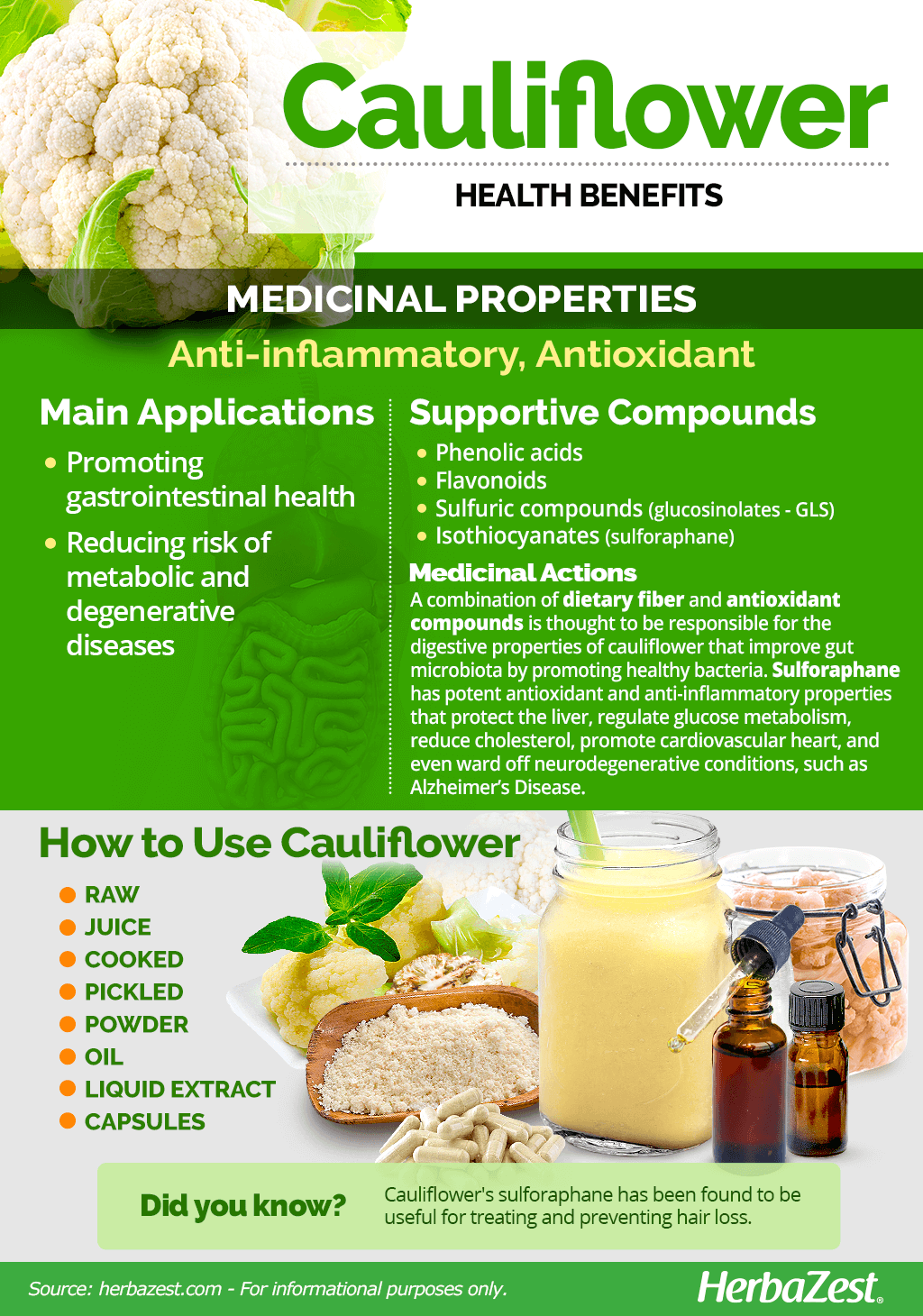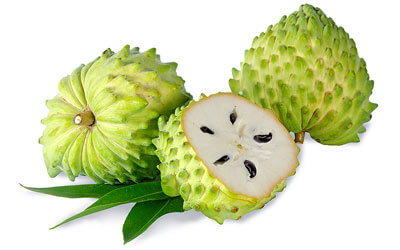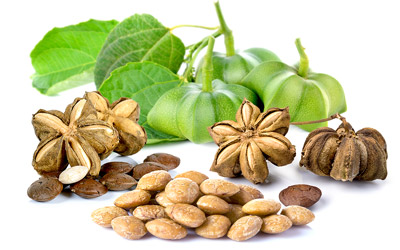Cauliflower, the cousin of broccoli, is an ancient vegetable, and the first records of its cultivation can be traced back to the 6th century. Prized for its mild flavor and beneficial properties, cauliflower is rich in vitamin C (ascorbic acid) and contains many potentially useful phytocompounds.
Cauliflower Medicinal Properties
- Medicinal action Anti-inflammatory, Digestive
- Key constituents Phenolic acids, flavonoids, sulfuric compounds (glucosinolates), isothiocyanates (sulforaphane)
- Ways to use Capsules, Liquid extracts, Food, Juiced, Powder, Essential oil
- Medicinal rating (4) Very useful plant
- Safety ranking Safe
Highly valued as a food staple in many culinary traditions, cauliflower contains many antioxidant and anti-inflammatory properties, with its seeds, leaves, and florets being used for medicinal preparations. Some of the most popular benefits of cauliflower for human health include:
Promoting gastrointestinal health. Rich in fiber and antioxidant compounds, cauliflower improves gut microbiota, relieving constipation and preventing colon related-diseases later in life.
Reducing risk of metabolic and degenerative diseases. There is some evidence that cauliflower can not only contribute to reducing high cholesterol levels, but it can also stabilize blood sugar levels as well as prevent coronary heart disease, and other common degenerative conditions.
Additionally, scientific studies have suggested the effectiveness of cauliflower for:
Repairing kidney and liver damage. Cauliflower is rich in antioxidant compounds that can help treat a variety of conditions caused by oxidative stress that damage internal organs.
Improving memory. Cauliflower consumption has been linked to enhanced cognitive functions and mood, delaying the onset of dementia and other neurodegenerative diseases.
How it works
The edible part of the cauliflower is rich in antioxidant compounds, such as phenolic acids, flavonoids, carotenoids and ascorbic acid. However, glucosinates are sulfuric compounds (present across cruciferous vegetables) to which most antioxidant and anti-inflammatory benefits of cauliflower are attributed. A breakdown product of glucosinates are isothiocyanates, which have proven to stimulate the production of detoxifying enzymes that play a key role in inflammatory processes. Isothiocyanates also have been shown to inhibit common bacterial strains, such as Helicobacter pylori, Escherichia coli, Pseudomonas aeruginosa, Listeria monocytogenes, and Staphylococcus aureus.
A combination of dietary fiber and antioxidant compounds is thought to be responsible for the digestive properties of cauliflower, particularly in its raw, uncooked form.1 Cauliflower, as well as other Brassica species, have been shown to improve gut microbiota by inhibiting harmful organisms that reduce the number of healthy bacteria.2
Sulforaphane, is a type of isothiocyanate with potent antioxidant and anti-inflammatory properties. This compound has been shown to reduce harmful cholesterol levels by preserving the function of pancreatic cells.3 This process also exerts a powerful effect on the metabolism of glucose within the pancreas, thus contributing to treating diabetes type II by significantly reducing blood sugar levels.4 Due to these actions, sulforaphane has proven to help improve and maintain metabolic and cardiovascular health.
Additionally, some pre-clinical evidence suggests that sulforaphane may play a key role in cognitive functions, delaying and preventing the onset of neurological diseases, such as dementia and Alzheimer's Disease.5,6
Cauliflower's sulforaphane has been found to be useful for treating and preventing hair loss.7
Other herbs that promote digestive health and improve gut flora are arracacha, amaranth, sweet potato, and yacon; whereas Brazil nut, stevia, and soursop help prevent metabolic diseases. Neuroprotective properties, on the other hand, can be found in herbs like sage, ginkgo biloba, and gotu kola.
Cautions & Side Effects
Cauliflower is considered safe for most people in moderate, culinary amounts. However, cauliflower contains mannitol, a complex carbohydrate that can't be digested by the small intestine, but, instead, it's eaten by bacteria, generating bloating and flatulence. People with IBS should avoid calciferous vegetables in general, including cauliflower, and the same advice goes to lactating mothers, since they can feed mannitol to their babies through breast milk.
Cauliflower also carries substances called goitrogens, which inhibit the availability of iodine and interfere with thyroid hormone production. This is why this cruciferous vegetable (along with other Brassica species) should be eaten in moderated amounts, or avoided altogether by people with iodine deficiency and hypothyroidism.
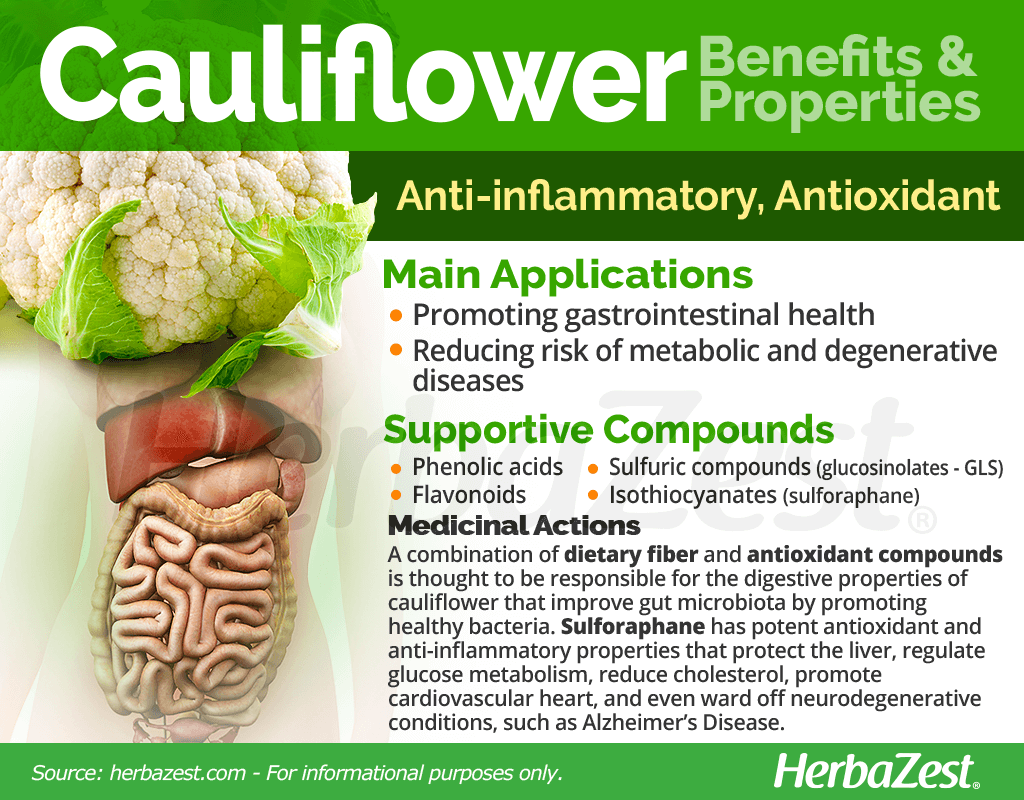
Cauliflower Nutrition
Cauliflower's nutritional profile includes good amounts of dietary fiber as well as a wide range of vitamins and minerals, with very little carbohydrates and calories per serving.
The most abundant minerals in cauliflower are manganese and potassium, both of which are essential for many bodily functions. Manganese is a trace mineral that plays an important role in the building of bones and connective tissue as well as in blood clotting and hormone production. On the other hand, potassium is essential for regulating blood pressure and cardiac function as well as nerves and muscle contraction. Cauliflower also provides adequate amounts of copper, magnesium, and phosphorus.
Cauliflower also offers generous amounts of vitamin C (ascorbic acid), a water soluble nutrient that usually fades away when exposed to heat, which is a very good reason to snack on raw or at least steamed cauliflower. Vitamin C is essential for tissue regeneration since it stimulates the production of collagen, but is also key for eye health and proper absorption of calcium.
Boiling cauliflower will significantly reduce the concentration of its water-soluble nutrients in 30 minutes or less.
Cauliflower also offers good amounts of folate, necessary for fetal development and function; vitamin K (phylloquinone), essential for blood coagulation and bones; vitamin B6 (pyridoxine), another water-soluble nutrient that is key for maintaining metabolic functions, brain development, and immunity; and pantothenic acid, which not only transforms food into energy, but also helps with the metabolism of fats.
Provided in good quantities by this cruciferous vegetable, choline is an essential nutrient for the brain. It not only regulates the nervous system, but it is also involved in memory, mood, and muscular function. Other vitamins of the B group, provided in adequate amounts by cauliflower, are thiamin, riboflavin, and niacin.
100 grams of raw cauliflower provides 25 calories, 8% DV of dietary fiber, 2% DV of carbohydrates, and 4% DV of protein.
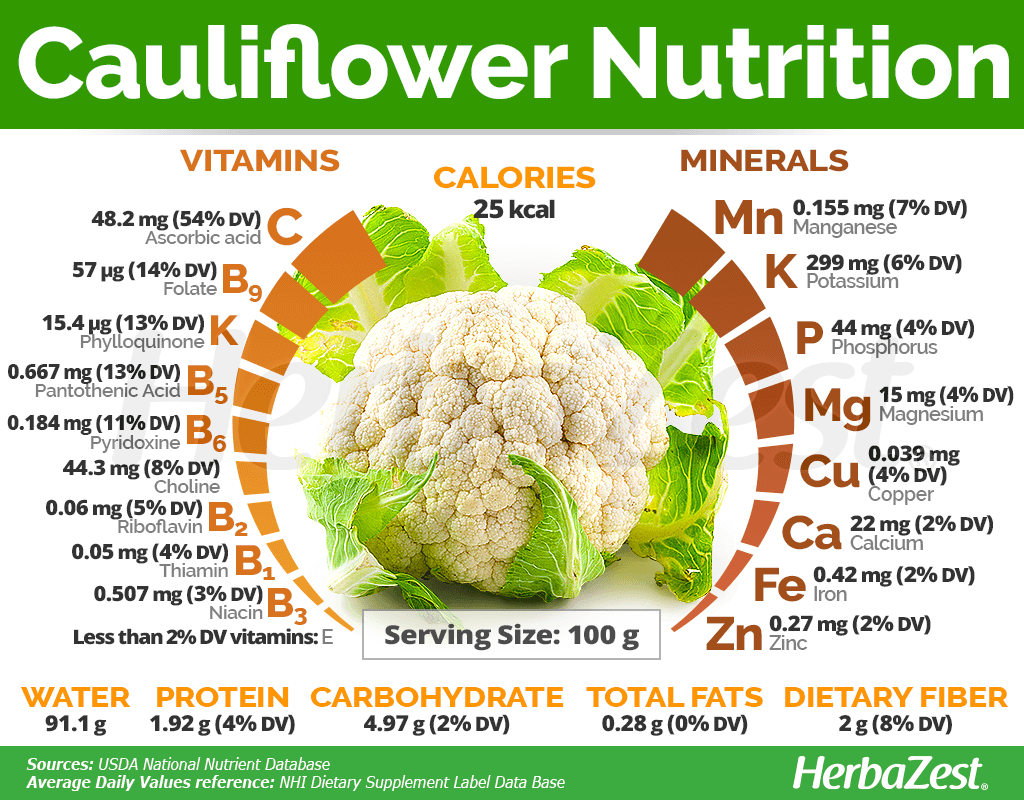
How to Consume Cauliflower
- Edible parts Flowers, Leaves, Stem
- Taste Mild
Cauliflower is very popular in the kitchen, and it can be eaten a few different ways; however, raw, steamed, microwaved, or stir fried are the best for keeping nutritional benefits intact. Low-carb dieters favor cauliflower crust in pizza as it contains less starch. Cauliflower can also take the place of potatoes or rice in a meal. Lesser known are the medicinal forms of cauliflower, which allow for better absorption of its healing compounds.
Natural Forms
Raw. In its raw form, cauliflower's edible parts, mainly the florets, retain all their nutritional and medicinal compounds. However, people with sensitive stomachs should be careful since some compounds of raw cauliflower may cause bloating and flatulence.
Juiced. The juice extracted from the cauliflower leaves and florets is rich in vitamins and antioxidant compounds, allowing for optimal absorption of nutrients.
Pickled. When preserved in vinegar, alone or with other vegetables, cauliflower promotes gut-friendly bacteria's growth and has a longer self-life.
Cooked. This is arguably the most popular way to consume cauliflower florets and stalks. There are many ways to prepare this healthy vegetable: roasted, boiled (although some nutrients are lost by the heat), steamed or blanched (both methods will help preserve its nutritional content).
Powder. Dried and pulverized cauliflower can be added to culinary preparations and healthy smoothies in order to reap its medicinal benefits.
The frozen cauliflower florets preserve their nutrients for a longer time, and are easy to found in supermarkets to be prepared at home.
Herbal Remedies & Supplements
Oil. Extracted from cauliflower seeds through a cold-pressed method, this oil is rich in carotene and vitamin C, among other antioxidant compounds. Popularly thought to have anti-aging and anti-inflammatory properties, some evidence suggests cauliflower oil may help treating hair loss as well as improving knee pain and skin health.
Liquid extract. Cauliflower extracts are rich in isothiocyanate, which exerts antimicrobial, antiparasitic, and anti-inflammatory activities. However, it may be toxic to the gastrointestinal tract when consumed in large doses. It is recommended to consult a physician before taking cauliflower extract to treat any health condition.
Capsules. For treating inflammatory conditions and promote healthy gut flora, cauliflower capsules are a great option, they concentrate the antioxidant properties of cauliflower and come in fixed doses, easy to take every day.
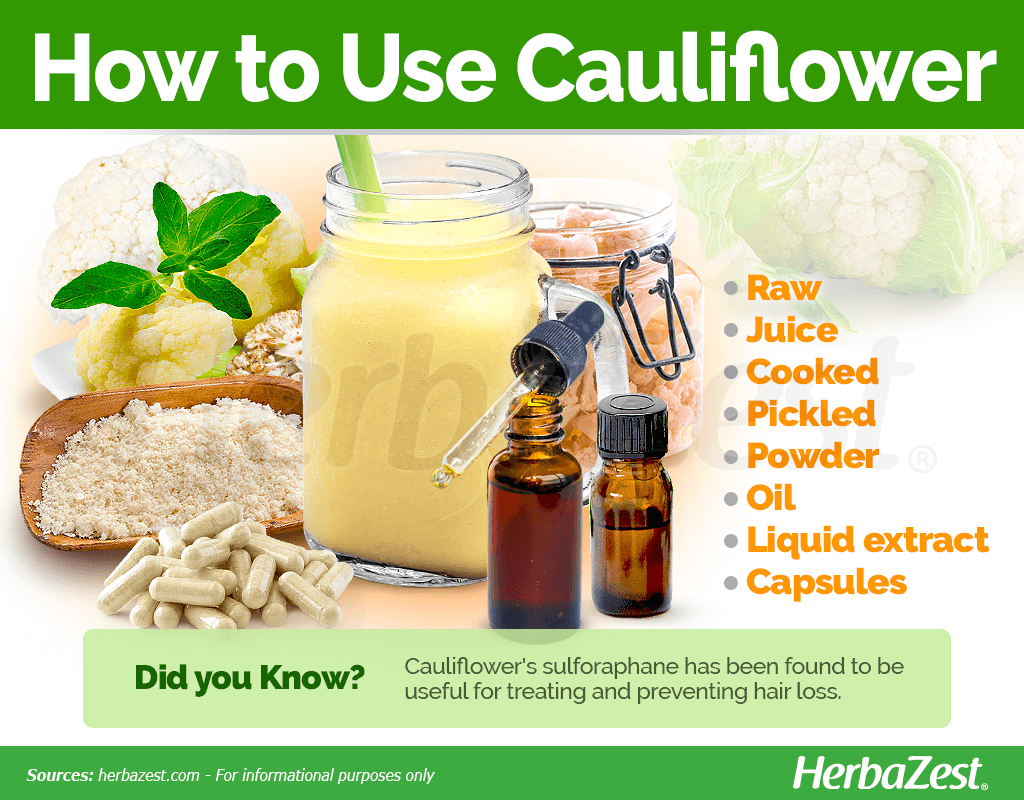
Growing
- Life cycle Annual
- Harvested parts Flowers, Seeds, Leaves, Stem
- Light requirements Full sun
- Soil Medium (loam), Well-drained
- Soil pH 6.1 – 6.5 (Slightly acidic), 6.6 – 7.3 (Neutral)
- Growing habitat Temperate climates
- Plant spacing average 0.1 m (0.30 ft)
- Growing time 50 to 60 days
- Potential insect pests Moths, Slugs, Caterpillars, Flea beetles, Snails
- Potential diseases Botrytis leaf spot, Alternaria blight, Black rot, Botrytis leaf blight, Club root
Cauliflower cultivation is labor intensive and it is mostly done on a commercial scale. However, it can be grown in personal gardens or backyards in a similar fashion as other Brassica varieties, as long as some basic conditions of temperature, soil, and cultural practices are met.
Growing guidelines
The cauliflower plant is sensitive to extreme temperatures, both cold and hot. This vegetable only thrives in mild weather, with an optimal temperature between 50 and 70°F (10-21°C).
The quality of the soil must be tested before planting, fertilizing with phosphorus (P) and potassium (K) as needed. It is also recommended to add well-rotted manure or compost during spring or fall in order to ensure that the cauliflower plants receive good nutrition.
For optimal development, cauliflower require well-drained, fertile soil with pH range of 6 to 7.
Cauliflower is grown from seeds, directly planted or previously germinated in peat pots with a soilless medium to be transplanted after six to eight weeks.
Cauliflower can be transplanted in spring, for an early harvest (50-60 days), or during late summer-early fall. It is recommended to use a row cover in order to protect the plants against insects and strong wind during their first weeks.
Cauliflower plants should be spaced 18 to 24 inches apart, with 36 to 48 inches between rows. A constant supply of water, manually or through an irrigation system, is needed in order to ensure a healthy crop.
Common cauliflower pests are flea beetles, worms, moth larvae, maggots, snails, slugs, and caterpillars. This cruciferous crop can also be affected by diseases like aternaria, black rot, and clubroot.
Additional Information
- Other uses Cosmetics
Plant Biology
Cauliflower is an annual crop that can be cultivated as biennial, depending on the variety. The cauliflower's head, commonly known as "curd," is on average six inches (15 cm) in diameter and it is comprised of undeveloped flower buds, or florets, which resemble tiny trees. Cauliflower plants come in four different colors: white, orange, green, and purple. However, white is the most common hue. The cauliflower curd is surrounded by big green leaves that protect it from sunlight.
Classification
Cauliflower (Brassica oleracea var. botrytis), is just one variety of Brassica oleracea, which belongs to the Brassicaceae family, and the genus Brassica is one of 372 genera within this large group, also known as the cabbage family, with over 4,000 accepted species.
There are 39 species within the genus Brassica, and the scientific name of Brassica oleracea has being assigned to a group of cultivars characterized by more or less densely-arranged branching and white to green inflorescences that form the "head" of the vegetables. Other well-known cruciferous vegetables, such as cabbage, broccoli, kale, radish, and Brussels sprouts, are also important members of the genus Brassica.Varieties and Cultivars of Cauliflower
Cauliflower is actually a cultivated variety, or cultivar of Brassica oleracea as well as other commercially grown crops, such as broccoli, Brussels sprouts, cabbage, collards, kale and kohlrabi.
The are many varieties of cauliflower, differentiated by color, time of maturation, resistance to plagues and diseases, and other characteristics. In terms of time of planting and harvesting, there are basically four types of cauliflower: early (harvested in summer), late (harvested in winter), overwinter (biennial types, ready to be harvested in spring), and tropical.
Historical Information
Although its exact original still being debated, cauliflower is thought to have originated somewhere in the Mediterranean region. While some scholars think it was introduced to Europe by the Arabs around the fall of the Roman Empire, others sustain they spread the cruciferous vegetable much later, and some think that cauliflower was brought to Italy from the Levant or Cyprus. However, the oldest written register about cauliflower only appears in 1576, in a German manuscript about herbs.
Cauliflower gained popularity early on, mainly in Turkey and Italy, where it became a staple vegetable.
Economic Data
The world biggest producers of cauliflower (and broccoli) are China and India, both of which combine 73% of the global market. In the United States (the third larger producer of cauliflower worldwide), California supplies 90% of this cruciferous vegetable to the national market, followed by Arizona. The total value of cauliflower production in the United States in 2020 was estimated at USD 346.391 million.
Other uses
Cosmetic industry. Due to its anti-aging properties, cauliflower oil is used in skin lotions and creams as well as in hair products.
Sources
- Agricultural Marketing Resource Center, Cauliflower, 2021
- Antioxidants (Basel), Variation in the Accumulation of Phytochemicals and Their Bioactive Properties among the Aerial Parts of Cauliflower, 2021
- BioMed Research International, Bioactive Compounds and Antioxidant Activity of Fresh and Processed White Cauliflower, 2013
- Cauliflower - Over 70 Exciting Ways to Roast, Rice, and Fry One of the World's Healthiest Vegetables, 2018
- Encyclopedia of Food and Health, Brassica: Characteristics and Properties, 2016
- Journal of Applied Horticulture, Measuring technical efficiency of the cauliflower cultivation in Blangladesh: A case study on Dhaka district, 2021
- Mediterranean Vegetables, p. 97
- Nutraceuticals, Chapter 40 - Glucosinates, 2016
- Oregon State University, Cruciferous Vegetables
- University of Illinois, Watch Your Garden Grow: Cauliflower
- University of Minessota, Extension, Growing cauliflower in home gardens
- University of Warwick, Research Says Boiling Broccoli Ruins Its Anti Cancer Properties
- West Virginia University, Extension, Growing Cauliflower
Footnotes:
- Preventive Nutrition and Food Science. (2019). Effect of Cooking Method on Antioxidant Compound Contents in Cauliflower. Retrieved March 15, 2023, from: https://www.ncbi.nlm.nih.gov/pmc/articles/PMC6615361/
- Molecular Nutrition & Food Research. (2017). Consumption of a diet rich in Brassica vegetables is associated with a reduced abundance of sulphate‐reducing bacteria: A randomised crossover study. Retrieved March 15, 2023, from: https://www.ncbi.nlm.nih.gov/pmc/articles/PMC5600105/
- Oxidative Medicie and Cellular Longetivy. (2017). Sulforaphane Protects against High Cholesterol-Induced Mitochondrial Bioenergetics Impairments, Inflammation, and Oxidative Stress and Preserves Pancreatic β-Cells Function. Retrieved March 15, 2023, from: https://www.ncbi.nlm.nih.gov/pmc/articles/PMC5366224/
- Food Science & Nutrition. (2021). The protective effect of sulforaphane on type II diabetes induced by high‐fat diet and low‐dosage streptozotocin. Retrieved March 15, 2023, from: https://www.ncbi.nlm.nih.gov/pmc/articles/PMC7866575/
- International Journal of Molecular Sciences. (2021). Pre-Clinical Neuroprotective Evidences and Plausible Mechanisms of Sulforaphane in Alzheimer's Disease. Retrieved March 15, 2023, from: https://www.ncbi.nlm.nih.gov/pmc/articles/PMC7999245/
- Austin Journal of Cerebrovascular Disease & Stroke. (2017). Sulforaphane Protects against Brain Diseases: Roles of Cytoprotective Enzymes. Retrieved March 15, 2023, from: https://austinpublishinggroup.com/cerebrovascular-disease-stroke/fulltext/ajcds-v4-id1054.php
- Cosmetics. (2021). Sulforaphane, L-Menthol, and Dexpanthenol as a Novel Active Cosmetic Ingredient Composition for Relieving Hair Loss Symptoms. Retrieved March 15, 2023, from: https://www.mdpi.com/2079-9284/8/3/63/htm
